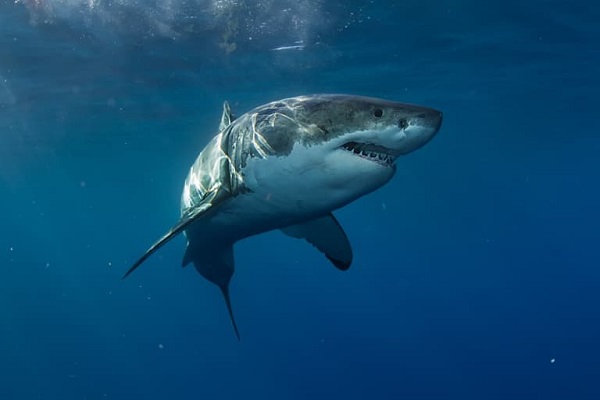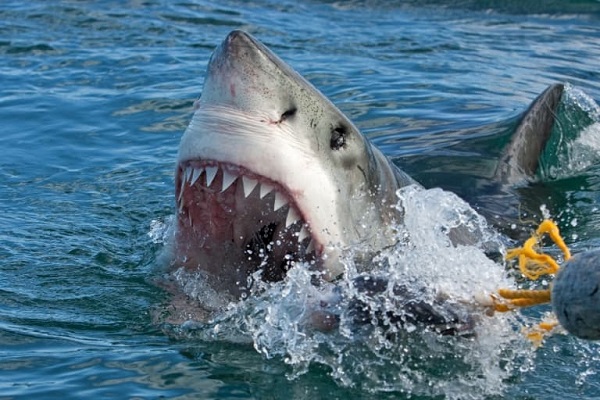
The great white sharks are called “great white” because of their white underbelly. They are apex predators and are popular for being incredible hunters. Their diet includes fish, marine mammals, sea turtles and seabirds. The only things known to hunt great whites are orcas and other sharks.
They are primarily unaccompanied, they only come together mainly for mating. Although some pairs have been seen travelling together.
They are well adapted for hunting, with up to 300 serrated teeth, the ability to detect blood from 5km away and torpedo-shaped bodies that allow them to swim up to 57 km/h. They use these adaptations to attack their prey at high speed, often breaching the surface of the water.
Below are 25 interesting facts about the great white sharks.
1. Great White Sharks Are The Largest Predatory Fishes On Earth
They are on average around 4.5m long, with the largest ones on record measuring in at a massive 7m. They are the fourth biggest shark in the world, and the largest predatory shark in the world.
2. They Are Warm-blooded
Most sharks have been recorded to be cold-blooded, meaning they are unable to control their body temperatures, great white Sharks are known warm blooded. This means that they can raise and lower their body temperature, allowing them to live in colder waters.
3. They Are Almost Global
These creatures can be found in all major oceans and the only place in the world they don’t hunt and live is Antarctica.
4. Sharks Are Much Older Than Dinosaurs
Sharks, in some form or another, have been in existence for over 400 million years, making an incredible evolutionary achievement.
5. They Infrequently Bite Boats And Sink Them
Great white sharks have been known to bite boats up to 10m (33 ft) in length, and even sink a rubber boat that are easily pierced by their razor sharp teeth and strong jaws.
They have bumped or knocked people overboard, usually biting the boat from the stern. In one case in 1936, a large shark leapt completely into the South African fishing boat Lucky Jim, knocking a crewman into the sea.
6. They Have Up To 300 Serrated, Triangular Teeth
These teeth are in 5 rows and are 3.81-6.35cm long. They regularly lose and replace these teeth and may grow up to 200,00 of them in a lifetime.

7. They Are Camouflaged In Colour
The tops of their bodies are grey, to blend in with rocky coastal sea floors when seen from above. Their white bellies mean that when you see them from below, they blend into the sun shining from above.
8. Great Whites Can Swim Up To 56 kph (35 mph)
They are adapted to swim fast, with stream-lined torpedo-like bodies.
9. Great White Sharks Can Smell Blood From 4-5km Away
They are famous for being able to detect blood in small quantities, or from a long way away. They can also sense one drop of blood in 100 litres of water. This makes them have a very high sense of smell.
10. They Have Toxic Blood
Another incredible biological feature of great white sharks is their highly toxic blood. Research has shown that the levels of arsenic and mercury in their blood are so high that it would kill most animals. Great whites however, seem to be adapted to this toxicity and are unharmed by it.
11. They Can Leap Out Of The Ocean 10 Feet Into The Air
This incredible behaviour is called breaching. Sharks will swim rapidly towards the surface and fly as far as 10 feet into the air.
12. Their Dark Eyes Glow
Just to add to their scariness, their eyes glow in the dark. They have a layer of reflective cells behind the retina which allows them to see better in the dark.
13. They Can Sense Electrical Fields In Water (Electroception)
This ability is known as electroception, and great white sharks are very good at it. They can sense one-millionth of a volt in water. The main purpose of this ability is to find prey, as it means that sharks can sense the electrical fields of marine animals.
14. Great White Sharks Have Long Life Spans
Great white sharks live longer than we think or used to think. Previously estimates of shark lifespan were as short as 23 years, however, research has shown that they can live up to 70 years or more.
15. Shark Embryos Eat Their Siblings In The Womb
Shark embryos will eat smaller or weaker siblings in the womb. They also eat the mother’s unfertilised eggs to keep growing. This means that the sharks that make it out of the womb are the strongest and most likely to survive.
16. They Are Born Hunters
Baby sharks (called pups) initially grow inside an egg, but hatch while still in the womb. When they are born, they measure 4-5 feet and are completely ready for life. Straight away they swim off and hunt for small marine animals.
17. Adult White Sharks Are Cannibals
The adult great white sharks attack other sharks too, that is to say, sharks are not generally social animals, and when they meet other sharks (especially if they’re smaller) they will happily make a meal out of them.
18. They Taste Test With Their Tongue
Their tongue is made with a type of cartilage called basihyal. They use this tongue to taste test food to see if they like it.
19. Orca’s Hunts Great White Sharks
Great White Sharks are scared of orcas and with good reason as killer whales will hunt and eat sharks they encounter. They even know that great white sharks rely on their livers for buoyancy and will remove a shark’s liver with almost surgical precision.
20. They Make Use Of Their Teeth Like Hands
Shark teeth can move within the jaw, and they use this flexibility to understand what it is they’re biting.
21. They Are Curious Animals
Sharks are very curious about their surroundings and things in the water. One researcher recalls on multiple occasions seeing great whites swimming up to brightly coloured objects (paddle boards, buoys etc) and often taking a nibble of them.
22. The Great White Sharks Are In Danger Of Becoming Extinct
In recent years, their numbers have been massively decreasing, leading to them being labelled as vulnerable. This is because of human activities, with over-fishing and getting caught accidentally in fishing gear being two of the biggest causes.
23. They Don’t Confuse Humans For Seals.
This is a common myth which is highly unlikely to be true. As opposed to the torpedo-like attack sharks use with seals, attacks on humans involve slow quiet approaches and they typically swim away after one bite. Most likely, sharks bite humans out of curiosity.
24. Great White Sharks Rarely Attack Humans
Shark attacks on humans are very rare when considering the number of people swimming in the ocean every year and actual deaths are even lower. Between 2014-2018 there was an average of 82 unprovoked attacks and 4 fatalities per year globally. While rare, the Great White species is nevertheless responsible for the largest number of fatal unprovoked shark attacks on humans.
25. They Are Sometimes Called A ‘Great White’, Or ‘White Pointer’
They are labelled are such about their white underbelly



